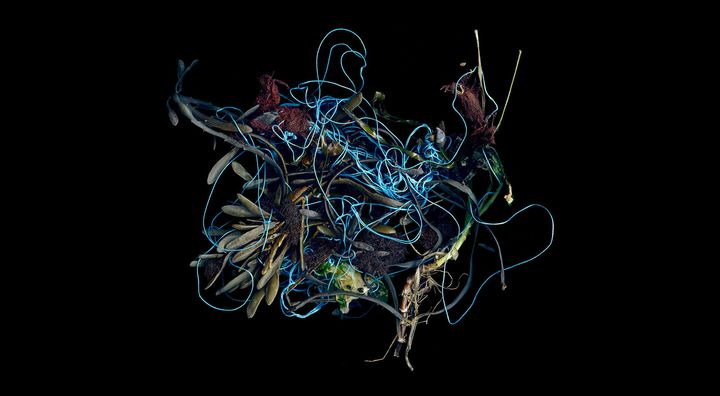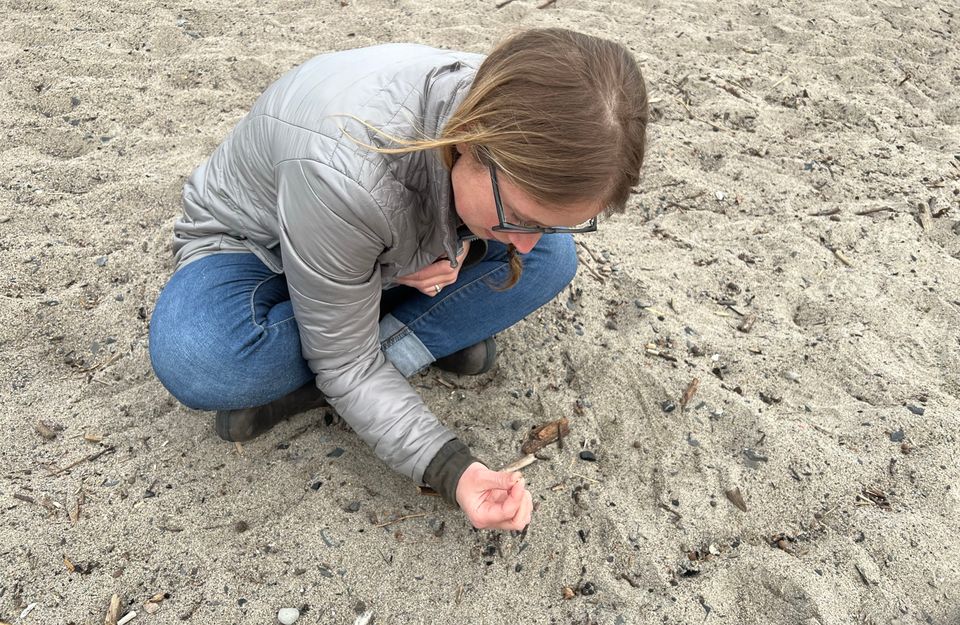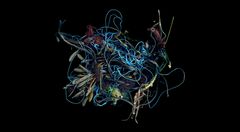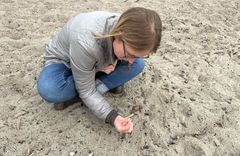Linking art and research to disseminate knowledge on plastic pollution

To the untrained eye it is just a solitary plastic bottle that looks like plastic pollution, but American photographer Elizabeth Ellenwood knows that she doesn’t need to look far before finding the first piece of plastic.
To view this piece of content from www.youtube.com, please give your consent at the top of this page.
“I’ve been collecting plastic here in the sand at Huk in Oslo since winter. So far I’ve found nearly 1,000 of these small plastic balls, that are carried on ships and used as a raw material for plastic. Because the pellets are so small and the cargo often isn’t properly secured, ton after ton end up in the ocean. Here they are eaten by fish and seabirds and enter the food chain,” Ellenwood explains.
She grew up by the ocean in Florida and Connecticut in the United States. Her love of the ocean and nature has prompted the photographer to use her camera and photography art to attract attention to plastic pollution.
“When I googled scientists working on the issue, researcher Hans Peter Arp from NGI appeared. So I sent an e-mail,” Ellenwood says.
“I was impressed with Elizabeth’s work and realised that this could be a good partnership,” says NGI researcher Hans Peter Arp.

Nature in change
With a Fulbright research grant Elizabeth has used the winter months at NGI, where art and science have been linked.
“I’ve spent many winter hours here in the sand at Huk collecting pieces of plastic, or 'nurdles' as we say in English,” Ellenwood says.
At NGI’s lab, one at a time, the small round pellets – that come in many colours – have been photographed using a microscope. After that, Arp and his colleagues have examined the chemical composition of the plastic.
“What does it mean to us when plastic and nature are linked? This is a big research issue we don’t yet know enough about. This is why we need more knowledge – including on which chemicals that can leach from this plastic and what it may mean for the environment in the ocean and on land in the long term,” Arp says.
The two hope that the link between art and science can open even more eyes to the problem.
“We understand by seeing. By making plastic into beautiful art, I want to invite everyone – across ages and barriers such as language – to understand and learn more about plastic pollution,” Ellenwood says.
Keywords
Contacts
Hans Peter ArpExpert AdviserEnvironmental Chemistry
Tel:+47 950 20 667hans.peter.arp@ngi.noImages


About NGI
På sikker grunn
NGI – Norges Geotekniske Institutt – er et uavhengig, internasjonalt senter for forskning og rådgivning innen ingeniørrelaterte geofag, der vi integrerer kunnskap mellom geoteknikk, geologi og geofysikk. Vår forskning gir kunnskap som styrker norsk næringsliv til å løse noen av de viktigste utfordringene vi står overfor innenfor klima, miljø, energi og naturfarer.
Gjennom årene har vi tiltrukket oss dedikerte fagfolk og internasjonale eksperter på bruk av geomaterialer som byggegrunn og byggemateriale, skredproblematikk og forurensning av grunnen. Utvikling og anvendelse av ny teknologi står helt sentralt i vår virksomhet for å finne bærekraftige løsninger og sikre at vi bygger et samfunn på sikker grunn. Vår ekspertise og løsninger er kjent og etterspurt i store deler av verden.
NGI har hovedkontor og laboratorier i Oslo, avdelingskontor i Trondheim, forskningsstasjon for snøskred på Strynefjellet, og utenlandskontorer med geoteknisk laboratorium i Houston, Texas, USA, og i Perth, Western Australia, i tillegg til samarbeidsavtaler med veletablerte selskap og institusjoner i store deler av verden.
NGI ble formelt opprettet 1. januar 1953, underlagt Norges Teknisk-Naturvitenskapelige Forskningsråd (NTNF). I 1985 ble NGI omgjort til en selvstendig stiftelse. Driftsvirksomheten (forskning og rådgivning) ble 1. januar 2024 overført til Norges Geotekniske Institutt AS, et aksjeselskap som eies 100 % av stiftelsen NGI.
Som en av hovedpartnerne støtter NGI Ingeniører Uten Grenser (IUG) økonomisk og gjennom å bidra med ingeniørkompetanse til IUGs oppdrag for norske bistandsorganisasjoner.
Subscribe to releases from NGI
Subscribe to all the latest releases from NGI by registering your e-mail address below. You can unsubscribe at any time.
Latest releases from NGI
Global modell skal gjøre verden bedre rustet mot tsunamier17.11.2025 11:46:45 CET | Pressemelding
Da en enorm flodbølge traff kystene rundt Indiahavet andre juledag i 2004, mistet mer enn 220 000 mennesker livet. Det var en katastrofe som rystet verden og som avslørte hvor lite vi egentlig forsto om tsunamier.
NGI-forsker valgt inn i styret til European Chemicals Agency (ECHA)24.10.2025 12:15:11 CEST | Pressemelding
Forsker ved NGI - Norges Geotekniske Institutt, Hans Peter Arp, er én av verdens fremste eksperter på kjemisk forurensning. Nå skal miljøkjemikeren påvirke kjemikaliepolitikken i Europa.
NGI lanserer unikt traineeprogram innen geoteknikk30.9.2025 09:11:00 CEST | Pressemelding
Fire nyutdannede ingeniører får nå muligheten til å prøve seg på tvers av NGIs kjerneområder. Gjennom et nytt traineeprogram skal de utforske alt fra fundamentering på land til havvind og klimatilpasning.
Flere velger geoteknikk og kvinneandelen skyter i været11.9.2025 08:55:38 CEST | Pressemelding
Masterstudiet i geoteknikk ved OsloMet vokser raskt. Da studiet startet i 2022, var det fem studenter og bare menn. Denne høsten har 21 nye studenter startet, av dem åtte kvinner.
Vi kan bygge tryggere tunneler med kunstig intelligens15.8.2025 14:51:34 CEST | Pressemelding
Kunstig intelligens endrer hvordan vi bygger tunneler. Vi kan forutsi farlige forhold i berget før vi treffer dem. Det gir tryggere tunneler, lavere kostnader, mindre naturinngrep og bedre beslutninger under bakken.
In our pressroom you can read all our latest releases, find our press contacts, images, documents and other relevant information about us.
Visit our pressroom
